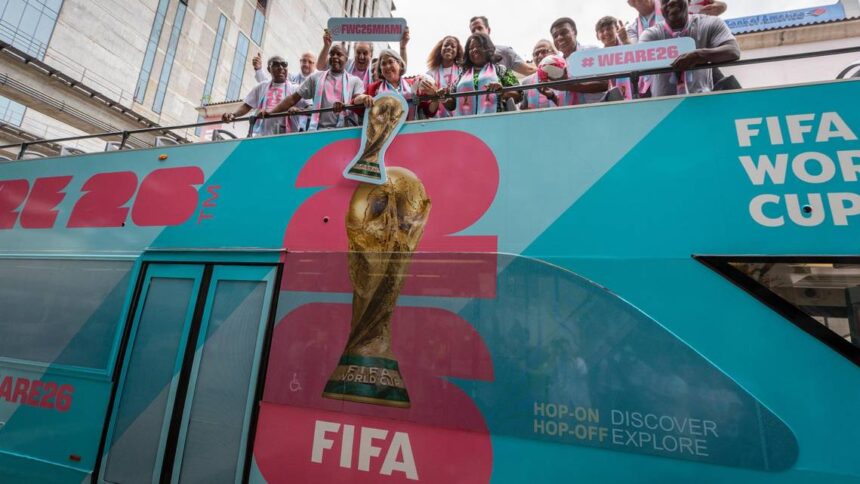Miami, Florida – May 18, 2023 – Miami-Dade County Mayor, Daniella Levine Cava, along with former soccer players and elected officials celebrate the unveiling of FIFA World Cup Miami 2026 on top of the double decker bus bearing the logo in front of the Government Center in downtown Miami.
jiglesias@elnuevoherald.com
Here’s a goal for the World Cup 2026 in Miami-Dade County: Spare the taxpayers a bill they can’t afford.
Hosting the World Cup is no small feat. It’s recognition that Miami is a top-notch international city with the fans to support world-class soccer.
But there’s a price for such an honor. And it just may be too much for Miami-Dade taxpayers to bear.
All the excitement generated after FIFA announced Miami would host seven World Cup matches— including three big ones — was dampened by a poorly prepared funding item submitted by Commission Chair Oliver Gilbert to the Miami-Dade County Commission on May 21.
It’s all very fuzzy pretty, without offering a breakdown of why a Miami World Cup organizing committee was asking for $46 million from the county to secure the seven games.
Taking into account that Miami-Dade contributed $10 million for the Super Bowl in 2020, some might quibble that $46 million for an international TV audience to catch Miami’s glam over seven games is not a bad deal. And about half of that money would purportedly come from the county’s bed tax on hotels and not from local taxpayers’ dollars.
Except: We have traversed this field before — a minefield of broken promises, bad accounting and poor construction that ended up costing taxpayers ever more money.
Local taxpayers are still scarred by the ever-escalating cost of building the Marlins’ stadium, with dashed promises to the Little Havana community that was supposed to gain from economic development surrounding the complex. And they are bracing for Miami Freedom Park, a soccer stadium and commercial complex built on a public golf course that could become one huge traffic bottleneck next to Miami International Airport and a noise and lighting nightmare for the local homes surrounding it. And there’s still no promised public park next to the Miami Heat arena on Biscayne Bay.
Miami FIFA Committee Chairman Rodney Barreto says the economic impact of the Super Bowl at the Dolphins’ stadium in Miami Gardens was $575 million. He expects the World Cup’s games from June 11 to July 19, 2026, will generate at least $1.5 billion. As many as 600,000 visitors are expected. And most will stay at local hotels (how many in Broward and not Miami-Dade, though?), keep Uber and Lyft drivers busy, eat at our restaurants and bars and shop if they so desire.
So, yes, there’s a lot to be excited about. But let’s get a true accounting of the costs first — not just pie-in-the-sky expectations. What’s the breakdown on costs? Why is so much money needed from taxpayers and how much money has already been committed from the local tourism “bed” tax for other needs, such as to support local arts, because those funds are limited?
Miami-Dade Mayor Daniella Levine Cava is right to be concerned. FIFA awarded Miami-Dade with the seven games based on the Greater Miami Sports Commission’s bid, and that nonprofit group worked with the county on the bid. Taxpayers are counting on the mayor, who oversees the county budget, to get all those financial details and find savings wherever possible.
At the May 21 meeting, there was some good news: County commissioners approved a World Cup spending plan that cuts in half the county’s cash contribution to $10.5 million. But they left another $10 million in a political “wait and see” in case more money is needed. And commissioners kept $25 million to contribute as in-kind services, mostly for public safety, which is a lot higher than at past big events. That cost will likely be borne by the general fund, aka money from local taxpayers.
The Miami FIFA Committee is raising another $100 million from the private sector. They should come up with more so that the working folks in this county don’t get hit with another sports project they can’t afford.
Make that the goal.

Click here to send the letter.











